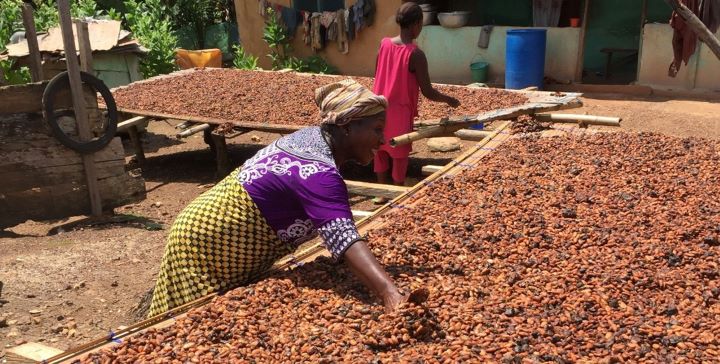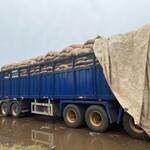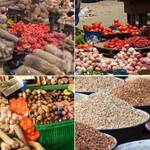It is feared that price gap between Ghana and Ivory Coast will lead to smuggling into Ivory Coast this 2022/203 cocoa season as Ghanaian farmers are expected to take advantage of higher prices in the neighbouring country.
The price of cocoa in Ivory Coast is higher than that of Ghana fueling speculation of possibly smuggling of the commodity by Ghanaian farmers.
Though Ghana raised the producer price for 2022/2023 cocoa season by 21%, far higher than the nine percent in Ivory Coast, the price per bag in Ghana is GH₵800 which is GH₵50 lower than the GH₵850 per bag in Ivory Coast.
The sharp depreciation of the cedi this year is said to be the reason the price per bag is higher in Ivory Coast despite that country raising farmgate price by just nine per cent compared to the 21% increase by Ghana.
The Ghana cedi plunged nearly 40% versus the dollar since the beginning of the year.
900 CFA franc per bag in Ivory Coast
Ivory Coast was the first to raise its cocoa producer price per bag by nine per cent from 825 CFA franc to 900 CFA franc.
The cedi equivalent of the 900 CFA franc per bag of cocoa weighing 64 kilogramme gross is GH₵850.
The CFA franc is the common currency of the 14 African countries belonging to the Franc Zone.
A week later, Ghana raised the producer price of cocoa by 21% to GH₵800 per bag for the 2022/2023 season effective October 7, 2022.
GH₵12,800 per metric tonne
This translates into GH₵12,800 per metric tonne up from GH₵10,560 in the 201/2022 cocoa season.
The increase represents 89.99% of FoB price
The producer price represents 89.99% of the net Free on Board (FOB) value.
People have been illegally transporting, or smuggling, cocoa beans between Ivory Coast and neighboring Ghana for many years.
As long as buyers in Ivory Coast will pay more for Ghana’s higher-quality beans, the smuggling is likely to continue.
Cocoa smuggling between Ghana and Ivory Coast is quite common, with its direction shifting back and forth depending on the price difference between the two countries.
Economic woes have hurt farmers, who say basic operational costs, including the price of farm inputs such as fertilizer, chemicals have risen sharply some as high as 300%.
Under Ghanaian law, farmers are only allowed to sell their beans to purchasing clerks who act as intermediaries between them and Ghana Cocoa Board (COCOBOD).
$400 Living Income Differential
Ivory Coast and Ghana teamed up and agreed to sell cocoa with a living income premium of $400 a tonne added to the price, in a bid to reform the way global cocoa is priced.
Forward sale of 80% of cocoa beans
Ghana and Ivory Coast, which account for about 60% of global cocoa output, typically sell about 80% of the main harvest before the beginning of every season, a system which allows it to lock in prices and set the minimum pay for farmers.
Two-cycle cocoa season in Ghana
The country operates a two-cycle cocoa season, consisting of the main crop, which is mainly exported to Europe at a premium, and a light crop harvest, which is discounted by around 20% to local grinders.
Over 2m small-scale farms in both countries
Over two million small-scale farms in Ivory Coast and Ghana produce nearly 60% of the world’s supply of cocoa.
Ghana, Ivory Coast get only $5.75bn out of $100bn chocolate market
While the two countries contributed to more than 60% of the world’s cocoa output, their total earning from the sale of cocoa beans amounted to a paltry $5.75 billion whereas the chocolate market was worth some $100 billion in that same year.
Ghana, Ivory Coast produce 60% of world’s cocoa
It means that the farmers whose toil and sweat produced 60% plus of the world’s cocoa earned 5.75% of the global value of their activity.
Nestlé’s annual sales dwarfs GDP of Ivory Coast and Ghana
According to the World Bank, Ivory Coast and Ghana have combined gross domestic product (GDP) of $69.3 billion, a figure dwarfed by Nestlé’s $90 billion in annual sales or a market cap of around $250 billion.
London and New York terminal markets
London and New York terminal markets, using mechanically programmed formulas, determine the price of cocoa.
Cocoa sector contributes 4.22% to GDP
The cocoa sector contributes 4.22% of gross domestic product (GDP), 30% of Ghana’s export earnings.
- Church of Jesus Christ, Ga Mantse Foundation renovate Adabraka School - 27 June 2024
- Manufacturers, Trade Minister tussle over proposed cement price regulation - 26 June 2024
- Work begins on Nima-Paloma drains - 26 June 2024




